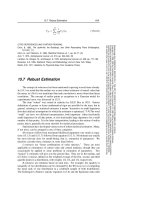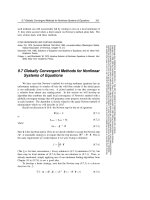Verilog Programming part 8 ppt
Bạn đang xem bản rút gọn của tài liệu. Xem và tải ngay bản đầy đủ của tài liệu tại đây (34.66 KB, 6 trang )
.2 Ports
Ports provide the interface by which a module can communicate with its
environment. For example, the input/output pins of an IC chip are its ports. The
environment can interact with the module only through its ports. The internals of
the module are not visible to the environment. This provides a very powerful
flexibility to the designer. The internals of the module can be changed without
affecting the environment as long as the interface is not modified. Ports are also
referred to as terminals.
4.2.1 List of Ports
A module definition contains an optional list of ports. If the module does not
exchange any signals with the environment, there are no ports in the list. Consider
a 4-bit full adder that is instantiated inside a top-level module Top. The diagram
for the input/output ports is shown in Figure 4-3
.
Figure 4-3. I/O Ports for Top and Full Adder
Notice that in the above figure, the module Top is a top-level module. The module
fulladd4 is instantiated below Top. The module fulladd4 takes input on ports a, b,
and c_in and produces an output on ports sum and c_out. Thus, module fulladd4
performs an addition for its environment. The module Top is a top-level module in
the simulation and does not need to pass signals to or receive signals from the
environment. Thus, it does not have a list of ports. The module names and port lists
for both module declarations in Verilog are as shown in Example 4-2
.
Example 4-2 List of Ports
module fulladd4(sum, c_out, a, b, c_in); //Module with a list of ports
module Top; // No list of ports, top-level module in simulation
4.2.2 Port Declaration
All ports in the list of ports must be declared in the module. Ports can be declared
as follows:
Verilog Keyword Type of Port
input Input port
Verilog Keyword Type of Port
output Output port
inout Bidirectional port
Each port in the port list is defined as input, output, or inout, based on the direction
of the port signal. Thus, for the example of the fulladd4 in Example 4-2
, the port
declarations will be as shown in Example 4-3
.
Example 4-3 Port Declarations
module fulladd4(sum, c_out, a, b, c_in);
//Begin port declarations section
output[3:0] sum;
output c_cout;
input [3:0] a, b;
input c_in;
//End port declarations section
<module internals>
endmodule
Note that all port declarations are implicitly declared as wire in Verilog. Thus, if a
port is intended to be a wire, it is sufficient to declare it as output, input, or inout.
Input or inout ports are normally declared as wires. However, if output ports hold
their value, they must be declared as reg. For example, in the definition of DFF, in
Example 2-5
, we wanted the output q to retain its value until the next clock edge.
The port declarations for DFF will look as shown in Example 4-4
.
Example 4-4 Port Declarations for DFF
module DFF(q, d, clk, reset);
output q;
reg q; // Output port q holds value; therefore it is declared as reg.
input d, clk, reset;
endmodule
Ports of the type input and inout cannot be declared as reg because reg variables
store values and input ports should not store values but simply reflect the changes
in the external signals they are connected to.
Note that the module fulladd4 in Example 4-3
can be declared using an ANSI C
style syntax to specify the ports of that module. Each declared port provides the
complete information about the port. Example 4-5
shows this alternate syntax. This
syntax avoids the duplication of naming the ports in both the module definition
statement and the module port list definitions. If a port is declared but no data type
is specified, then, under specific circumstances, the signal will default to a wire
data type.
Example 4-5 ANSI C Style Port Declaration Syntax
module fulladd4(output reg [3:0] sum,
output reg c_out,
input [3:0] a, b, //wire by default
input c_in); //wire by default
<module internals>
endmodule
4.2.3 Port Connection Rules
One can visualize a port as consisting of two units, one unit that is internal to the
module and another that is external to the module. The internal and external units
are connected. There are rules governing port connections when modules are
instantiated within other modules. The Verilog simulator complains if any port
connection rules are violated. These rules are summarized in Figure 4-4
.
Figure 4-4. Port Connection Rules
Inputs
Internally, input ports must always be of the type net. Externally, the inputs can be
connected to a variable which is a reg or a net.
Outputs
Internally, outputs ports can be of the type reg or net. Externally, outputs must
always be connected to a net. They cannot be connected to a reg.
Inouts
Internally, inout ports must always be of the type net. Externally, inout ports must
always be connected to a net.
Width matching
It is legal to connect internal and external items of different sizes when making
inter-module port connections. However, a warning is typically issued that the
widths do not match.
Unconnected ports
Verilog allows ports to remain unconnected. For example, certain output ports
might be simply for debugging, and you might not be interested in connecting
them to the external signals. You can let a port remain unconnected by
instantiating a module as shown below.
fulladd4 fa0(SUM, , A, B, C_IN); // Output port c_out is unconnected
Example of illegal port connection
To illustrate port connection rules, assume that the module fulladd4 in Example 4-
3 is instantiated in the stimulus block Top. Example 4-6 shows an illegal port
connection.
Example 4-6 Illegal Port Connection
module Top;
//Declare connection variables
reg [3:0]A,B;
reg C_IN;
reg [3:0] SUM;
wire C_OUT;
//Instantiate fulladd4, call it fa0
fulladd4 fa0(SUM, C_OUT, A, B, C_IN);
//Illegal connection because output port sum in module fulladd4
//is connected to a register variable SUM in module Top.
.
.
<stimulus>
.
.
endmodule
This problem is rectified if the variable SUM is declared as a net (wire).
4.2.4 Connecting Ports to External Signals
There are two methods of making connections between signals specified in the
module instantiation and the ports in a module definition. These two methods
cannot be mixed. These methods are discussed in the following sections.
Connecting by ordered list
Connecting by ordered list is the most intuitive method for most beginners. The
signals to be connected must appear in the module instantiation in the same order
as the ports in the port list in the module definition. Once again, consider the
module fulladd4 defined in Example 4-3
. To connect signals in module Top by
ordered list, the Verilog code is shown in Example 4-7
. Notice that the external
signals SUM, C_OUT, A, B, and C_IN appear in exactly the same order as the
ports sum, c_out, a, b, and c_in in module definition of fulladd4.
Example 4-7 Connection by Ordered List
module Top;
//Declare connection variables
reg [3:0]A,B;
reg C_IN;
wire [3:0] SUM;
wire C_OUT;
//Instantiate fulladd4, call it fa_ordered.
//Signals are connected to ports in order (by position)
fulladd4 fa_ordered(SUM, C_OUT, A, B, C_IN);
<stimulus>
endmodule
module fulladd4(sum, c_out, a, b, c_in);
output[3:0] sum;
output c_cout;
input [3:0] a, b;
input c_in;
<module internals>
endmodule
Connecting ports by name
For large designs where modules have, say, 50 ports, remembering the order of the
ports in the module definition is impractical and error-prone. Verilog provides the
capability to connect external signals to ports by the port names, rather than by
position. We could connect the ports by name in Example 4-7
above by
instantiating the module fulladd4, as follows. Note that you can specify the port
connections in any order as long as the port name in the module definition
correctly matches the external signal.
// Instantiate module fa_byname and connect signals to ports by name
fulladd4 fa_byname(.c_out(C_OUT), .sum(SUM), .b(B), .c_in(C_IN), .a(A),);
Note that only those ports that are to be connected to external signals must be
specified in port connection by name. Unconnected ports can be dropped. For
example, if the port c_out were to be kept unconnected, the instantiation of
fulladd4 would look as follows. The port c_out is simply dropped from the port
list.
// Instantiate module fa_byname and connect signals to ports by name
fulladd4 fa_byname(.sum(SUM), .b(B), .c_in(C_IN), .a(A),);
Another advantage of connecting ports by name is that as long as the port name is
not changed, the order of ports in the port list of a module can be rearranged
without changing the port connections in module instantiations.









